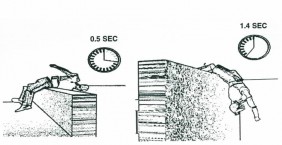Bernd Remy, a young businessman from Germany, was standing in the parking lot behind his hotel in Lexington, Massachusetts, enjoying an after-dinner smoke with a colleague, when he heard what sounded like a low flying airplane. He turned to look up and, according to his colleague; Mr. Remy disappeared from view in the early darkness. “I heard a low moan and suddenly he was gone,” the colleague recalled. The young man had backed up a few steps while looking up and in the poor light he struck the outside corner of a low brick wall along the walkway with enough momentum to go over the ledge.
An emergency crew found him at the bottom of an eleven-foot pit, curled up in a fetal position with a broken neck. The doctors saved his life, but the accident left him a paraplegic, confined to a wheelchair for life. The hotel at first refused to admit liability, but to prevent litigation the owners offered to settle the case for $1.5 million.
Not satisfied with the offer, the victim retained the legal services of Richard Bickelman of the firm of Deutsch, Williams, Brooks, DeRensis, Holland & Drachman in Boston, which in turn called in Technology Associates (TA) to reconstruct the accident. In a preliminary analysis, Irving Ojalvo, ScD, the lead investigator for Technology Assoc., showed that the wall was so low that the victim’s center of gravity was actually higher than the height of the wall and that with sufficient speed, he could travel over the 1-foot wide ledge. The attorney for the plaintiff thereupon decided to ask for a settlement of $6 million, which the hotel turned down.

To strengthen his case, Dr. Ojalvo turned to a computer model created by the U.S. Department of Transportation for use in the design of crash-safe vehicles. Starting with the position of the accident victim at the bottom of the pit, and using his height, weight and other physical properties, Dr. Ojalvo and Dr. Yanowitz, another member of his investigative team, helped Advanced Imaging create an animated video, based on a dynamic simulation of body motions, which detailed what had happened. They concluded that the victim would have ended up as found only by backing into the wall and developing enough momentum to go over the ledge. After viewing the compelling animated recreation of the accident, the defendants re-thought their position and agreed to close the case for $4.5 million — three times their original offer.